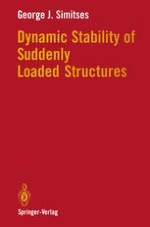1990 | Buch
Über dieses Buch
Dynamic instability or dynamic buckling as applied to structures is a term that has been used to describe many classes of problems and many physical phenomena. It is not surprising, then, that the term finds several uses and interpretations among structural mechanicians. Problems of parametric resonance, follower-force, whirling of rotating shafts, fluid-solid interaction, general response of structures to dynamic loads, and several others are all classified under dynamic instability. Many analytical and experimental studies of such problems can be found in several books as either specialized topics or the main theme. Two such classes, parametric resonance and stability of nonconservative systems under static loads (follower-force problems), form the main theme of two books by V. V. Bolotin, which have been translated from Russian. Moreover, treatment of aero elastic instabilities can be found in several textbooks. Finally, analytical and experimental studies of structural elements and systems subjected to intense loads (of very short duration) are the focus of the recent monograph by Lindberg and Florence. The first chapter attempts to classify the various "dynamic instability" phenomena by taking into consideration the nature of the cause, the character of the response, and the history of the problem. Moreover, the various concepts and methodologies as developed and used by the various investigators for estimating critical conditions for suddenly loaded elastic systems are fully described. Chapter 2 demonstrates the concepts and criteria for dynamic stability through simple mechanical models with one and two degrees of freedom.
Anzeige
